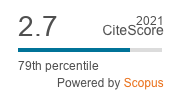Advanced Statistical Methods for Credit Risk Scoring: A Bayesian and Non- Parametric Approach
Abstract
Finance-related decisions heavily depend on credit risk evaluation processes because these determine both lending practices and operational risk management methods of institutions. Logistic regression functions as the initial process for statistical models to conduct credit risk evaluation yet standard approaches face difficulties when dealing with complex patterns together with uncertainties. The study implements an advanced framework which merges Bayesian statistical capabilities with non-parametric methods with AI modeling techniques to boost credit risk evaluation accuracy. Standard logistic regression with Lasso/Ridge penalty functions as the first method that leads to Bayesian logistic regression for enhanced estimation stability. The study utilizes kernel density estimation for non-parametric analysis to model credit risk allocation and employs quantile regression to determine high-risk borrowers independently from average effect perceptions. The paper explores the performance of XGBoost AI classifiers together with Support Vector Machines (SVM) as well as Bayesian logistic regression and traditional Support Vector Machines (SVM) and XGBoost to analyze predictive
accuracy and robustness potential. The proposed risk segmentation system combines quantile regression methods with Bayesian logistic regression for generating better decisions by using AI-enabled processes. The presented method achieves superior results on actual credit risk datasets through improved outcomes along with uncertainty reduction capabilities while providing better interpretative insight. This statistically advanced framework enables researchers to boost traditional credit risk modeling techniques because it demonstrates superior performance outcomes.
References
Altinbas, H., & Akkaya, G. C. (2017). Improving the performance of statistical learning methods with a combined meta-heuristic for consumer credit risk assessment. Risk Management, 19, 255–280.
Amaro, M. M. (2020). Credit scoring: comparison of non-parametric techniques against logistic regression (Master's thesis, Universidade NOVA de Lisboa (Portugal)).
Ashofteh, A., & Bravo, J. M. (2019). A non-parametric-based computationally efficient approach for credit scoring.
Ashofteh, A., & Bravo, J. M. (2021). A conservative approach for online credit scoring. Expert Systems with Applications, 176, 114835.
Bou-Hamad, I. (2017). Bayesian credit ratings: A random forest alternative approach. Communications in Statistics Theory and Methods, 46(15), 7289–7300.
Cerchiello, P., & Guidici, P. (2014). Bayeslan credit ratings. Communications in Statistics-Theory and Methods, 43(4), 867–878.
Chen, H., Jiang, M., & Wang, X. (2017, July). Bayesian ensemble assessment for credit scoring. In 2017 4th International Conference on Industrial Economics System and Industrial Security Engineering (IEIS) (pp. 1–5). IEEE.
Chen, N., Ribeiro, B., & Chen, A. (2016). Financial credit risk assessment: a recent review. Artificial Intelligence Review, 45, 1–23.
Coolen-Maturi, T., & Coolen, F. P. A. (2019). Non-parametric predictive inference for the validation of credit rating systems. Journal of the Royal Statistical Society Series A: Statistics in Society, 182(4), 1189–1204.
Dong, H., Liu, R., & Tham, A. W. (2024). Accuracy comparison between five machine learning algorithms for financial risk evaluation. Journal of Risk and Financial Management, 17(2), 50.
Gunnarsson, B. R., Vanden Broucke, S., Baesens, B., Óskarsdóttir, M., & Lemahieu, W. (2021). Deep learning for credit scoring: Do or don’t?. European Journal of Operational Research, 295(1), 292–305.
Dua, D., & Graff, C. (2024). UCI Machine Learning Repository: German Credit Dataset. Retrieved from https://archive.ics.uci.edu/ml/datasets/Statlog+(German+Credit+Data).
Han, S., & Jung, H. (2024). NATE: Non-pArameTric approach for Explainable credit scoring on imbalanced class. PloS one, 19(12), e0316454.
Hooman, A., Marthandan, G., Yusoff, W. F. W., Omid, M., & Karamizadeh, S. (2016). Statistical and data mining methods in credit scoring. The Journal of Developing Areas, 50(5), 371–381.
Hounnou, L. (2024). Harnessing the power of machine learning, Bayesian neural networks, and spatial analysis in modeling a predictive system, credit risk, and organizational performance across continents (Doctoral dissertation, University of Illinois at Urbana-Champaign).
Jaber, J. J., Ismail, N., & Ramli, S. N. M. (2017). Credit risk assessment using survival analysis for progressive right-censored data: a case study in Jordan. J. Internet Banking Commer., 22
Jaber, J. J., Ismail, N., & Ramli, S. N. M. (2017, April). Evaluation of portfolio credit risk based on survival analysis for progressive censored data. In AIP Conference Proceedings (Vol. 1830, No. 1). AIP Publishing.
Jha, P. N., & Cucculelli, M. (2021). A new model averaging approach in predicting credit risk default. Risks, 9(6), 114.
Kenny, J., & Chan, J. (2025). A Novel Approach to Credit Risk Sensitivity Categorisation and Classification Using Hierarchical Clustering, Kernel Density Estimation, and Naive Bayes Classification. Kernel Density Estimation, and Naive Bayes Classification (February 14, 2025).
Khemakhem, S., & Boujelbene, Y. (2018). Predicting credit risk on the basis of financial and non-financial variables and data mining. Review of accounting and finance, 17(3), 316–340.
Krichene, A. (2017). Using a naive Bayesian classifier methodology for loan risk assessment: Evidence from a Tunisian commercial bank. Journal of Economics, Finance and Administrative Science, 22(42), 3–24.
Levital, M. F., Khawaled, S., Kennedy, J. A., & Freiman, M. (2025). Non-parametric Bayesian deep learning approach for whole-body low-dose PET reconstruction and uncertainty assessment. Medical & Biological Engineering & Computing, 1-16.
Ramosaj, B., & Pauly, M. (2019). Predicting missing values: A comparative study on non-parametric approaches for imputation. Computational Statistics, 34(4), 1741–1764.
Rizvi, S. A. A. (2018). Analysis of financial time series using non-parametric Bayesian techniques (Doctoral dissertation, University of Oxford).
Teles, G., Rodrigues, J. J. P. C., Rabê, R. A., & Kozlov, S. A. (2020). Artificial neural network and Bayesian network models for credit risk prediction. Journal of Artificial Intelligence and Systems, 2(1), 118–132.
Yan, D., Xiong, Y., Zhan, Z., Liao, X., Ke, F., Lu, H., ... & Wang, Q. (2021). Research on eigenvalue selection method of power market credit evaluation based on non parametric Bayesian discriminant analysis and cluster analysis. Energy Reports, 7, 990–997
Downloads
Published
How to Cite
Issue
Section
License
Copyright (c) 2025 Results in Nonlinear Analysis

This work is licensed under a Creative Commons Attribution 4.0 International License.



